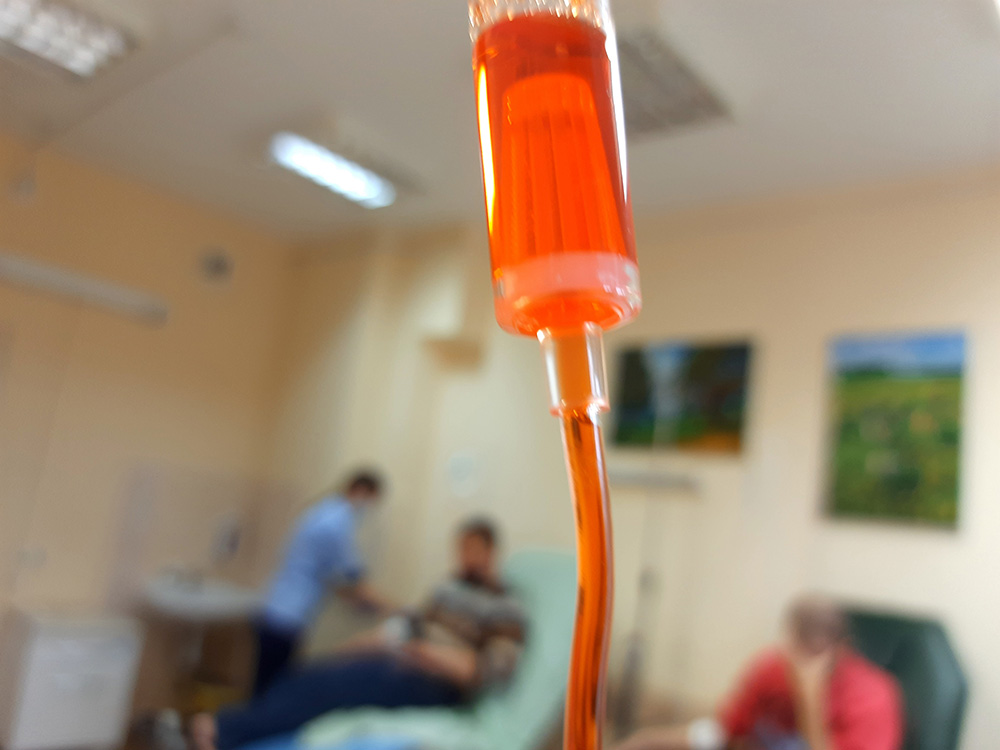What is the chemo drug called the Red Devil?
Overview
- The chemotherapy (“chemo”) drug “The Red Devil” is doxorubicin (Adriamycin). It is an intravenous cancer medicine with a clear, bright red color, which is how it got its nickname.
- Doxorubicin may also cause your urine or other body fluids to turn a reddish color for 1 to 2 days after a dose is given, which is normal and temporary.
- Doxorubicin can cause harsh side effects such as heart toxicity (heart failure), severe nausea and vomiting, and total hair loss (alopecia).
- The brand name product Adriamycin has now been discontinued in the U.S., but the generic doxorubicin is still on the market.

Doxorubicin, in the drug class known as anthracyclines, has been used for decades in the treatment of various solid cancers such as breast cancer and ovarian cancer, or blood cancers like leukemia or lymphoma. It works by inhibiting an enzyme known as topoisomerase 2 and blocking RNA and DNA synthesis, which leads to cell death.
Because of its heart toxicity (cardiotoxicity), doxorubicin has a maximum cumulative dose that can be given to each patient. The higher the total dose you receive over time, the greater your chance for heart side effects. Your doctor will monitor your heart before, during and after doxorubicin treatment. Patients typically receive injections every 21 to 28 days on a specific cycle, but your dose schedule may be different.
You may NOT be able to use doxorubicin if you have severe heart disease or severe liver disease. Contact your doctor right away if you feel extremely weak or tired, have a fast heartbeat, any level of shortness of breath, or swelling in your ankles or feet. A medicine known as dexrazoxane may be used to help protect your heart when receiving Adriamycin.
The liposomal form of doxorubicin (brand name: Doxil) has been developed as an alternative. It cannot be substituted on a mg-for-mg basis with regular doxorubicin. Liposomal doxorubicin is placed inside small fat particles (liposomes) which allows a longer blood circulation time.
Brand and generic forms of doxorubicin and doxorubicin liposomal are available in the U.S.
Related questions
- How long does chemo take? Sessions and recovery time?
- What is the strongest chemotherapy drug for breast cancer?
- How soon will my hair grow back after chemotherapy?
What are the most common side effects with the Red Devil?
The 3 most common side effects with doxorubicin are hair loss (alopecia), nausea and vomiting. Hair loss was seen in up to 92% of patients, and nausea and vomiting occurred in over 70% of patients. Your doctor will help control your nausea and vomiting with anti-nausea medicine before you receive doxorubicin.
Common side effects of doxorubicin may include:
- nausea and vomiting, which can be severe
- total hair loss (alopecia) - may fully or partially grow back after treatment
- diarrhea
- swollen mouth and mouth sores
- loss of appetite (anorexia)
- shortness of breath
- fatigue, extreme tiredness
- low platelets (thrombocytopenia)
- low white blood cell numbers in the blood (leukopenia), which may increase your risk for infections
Learn more: Doxorubicin Warnings and Side Effects (in more detail)
This is not all the information you need to know about doxorubicin or doxorubicin liposomal for safe and effective use and does not take the place of your doctor’s directions. Review the full product information and discuss any questions you have with your doctor or other health care provider.
References
- Doxorubicin prescribing information. Revised 3/2020. New York, NY. Pfizer Inc. Accessed Dec. 7, 2021 at https://www.accessdata.fda.gov/drugsatfda_docs/label/2020/050467s078,050629s030lbl.pdf
- Doxorubicin monograph. Drugs.com. Accessed Dec. 7, 2021 at https://www.drugs.com/mtm/doxorubicin.html
- Blanchard S. Can the Red Devil be Tamed? July 12, 2020. Accessed Dec. 7, 2021 at https://moffitt.org/endeavor/archive/can-the-red-devil-be-tamed/
Read next
Chemo side effects: What should I expect and how to cope?
Chemotherapy is a drug treatment used to kill fast-growing cancer cells in your body. While chemotherapy is an effective treatment for many types of cancer, it can also damage healthy cells that divide quickly, such as those in your hair follicles, digestive tract, and bone marrow. This widespread effect on healthy tissue is what causes the various side effects associated with chemotherapy treatment.
Continue reading
Will I lose my hair during chemotherapy treatment?
Chemotherapy-induced hair loss is common and usually temporary, caused by the drugs targeting rapidly dividing hair follicle cells. Hair loss typically starts a few weeks after treatment begins and regrows a few months after it ends.
Continue reading
Radiation vs. Chemo: Which cancer treatment is right for you?
Chemotherapy treats cancer throughout the body, while radiation targets specific areas. Each approach has unique benefits depending on the type and stage of cancer, as well as your overall health.
Continue readingSee also:
Related medical questions
- What is chemo brain and how long does it last?
- What is EPOCH/R-EPOCH chemo regimen and how is it used?
- What are CHOP and R-CHOP chemotherapy regimens?
- How soon can you start chemo after port placement?
- What is ABVD chemo regimen and how is it used for lymphoma?
- What is a chemotherapy regimen?
- How is Lartruvo administered?
- What is the lifetime or cumulative dose for Adriamycin?
- How does Adriamycin and Cytoxan (AC chemo) work for Breast Cancer?
- What are the long-term side effects of Adriamycin?
- Does Adriamycin cause heart failure?
Drug information
Related support groups
- Doxorubicin (18 questions, 13 members)
- Adriamycin (9 questions, 8 members)
- Doxorubicin Liposomal (2 questions, 4 members)
- Doxil (1 questions, 5 members)
